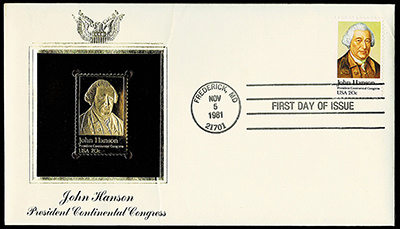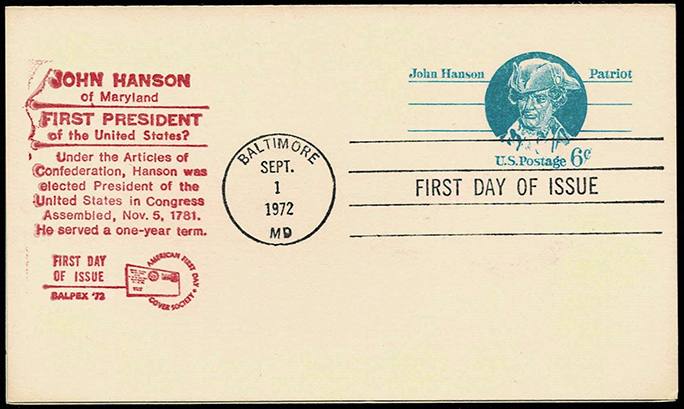
Maryland on Stamps…
‘President’ John Hanson:1972/1981
Richard D. L. Fulton
John Hanson was born in Port Tobacco Parish, Charles County, in 1721, to parents Samuel Hanson and Elizabeth Storey Hanson, and in 1781, arguably became the first president of the United States, eight years before the election of George Washington.
On September 1, 1972, the United States Postal Service (USPS) issued a 6 cent postal card, commemorating Hanson for his patriotism he had demonstrated during the American Revolution, including his involvement in having helped establish America’s first “rebel” congress.
Postal cards are official USPS-printed cards with the current stamps imprinted on them (as opposed to post cards, which are privately printed and to which a stamp must be affixed in order to mail them).
First-day-of- issue John Hanson postal cards were issued and canceled in the Baltimore Post office. The postal cards bore a portrait of Hanson, and additionally bore the inscription heading that read “John Hanson of Maryland, First President of the United States?”
On November 5, 1981, the USPS issued a 20-cent stamp, commemorating Hanson for his service as the president of the Continental Congress, and bore a portrait of Hanson, and first day of issue covers were canceled in the Frederick Post Office.
Hanson’s Early Career
John Hanson moved to Frederick City (as the city was once known to distinguish itself from Frederick County) in 1769, where he served as the deputy surveyor from 1769 to 1777. He also served as the sheriff of Frederick County beginning in 1771, according to the Archives of Maryland article, John Hanson (1721-1783).
In 1775, Hanson served as the chairman of the Frederick County Committee of Observation (which was involved in the assemblage of militia units to join the armed forces, then being assembled in Boston. In 1775, Hanson was also elected county treasurer.
Additional offices held by Hanson included having been a commissioner assigned in 1776 to assist with establishing an arms and ammunition factory in Frederick, and, in 1777, he was appointed as a loan officer to help raise funds for the Continental Congress.
From 1780 to 1782, he served as a delegate to the Continental Congress.
President John Hanson
Hanson served as a Maryland delegate to the Continental Congress from 1780 to 1783, and signed the Articles of Confederation in 1782, which had officially established the Continental Congress and the first United States of America.
Hanson assumed the title of president after he was elected “President of the United States in Congress Assembled” on November 5, 1781, under the Articles of Confederation.
Bear in mind that the Articles of Confederation established the first United States of America. The current United States of America was established in 1788, when the “founding fathers” had successfully convinced representatives of the 13 original states that had then comprised the United States to secede from the Articles of Confederation in order to establish a new United States.
Under Hanson’s presidency, the “first consular service was established, a post office department was initiated, a national bank was chartered, progress was made towards taking the first census, and a uniform system of coinage was adopted (among many other accomplishments),” according to the Architect of the Capitol.
Nevertheless, Hanson retained the title of president until November 4, 1782.
On November 15, 1783, at the age of 68, John Hanson passed away at the home of his nephew, Thomas Ganson, at Oxen Hill, Prince Georges County, according to the Archives of Maryland article, John Hanson (1721-1783).
Hanson’s Lost Grave
According to johnhansonmemorial.org, Hanson’s body was removed from a (family?) crypt and transported to the nearby Addison Cemetery in 1878. But the grave was never marked or the identification (head) stone was lost.
The johnhansonmemorial.org reported that in 2017, “forensics examination of 40 sets of (previously unidentified) remains from (buried within) the Addison Cemetery reveal a solitary unidentified elderly male who can only be John Hanson.”
All of the 40 sets of remains were removed and reinterred in the graveyard of St. John’s Episcopal Church in Fort Washington, including those of John Hanson.

1981 First Day of Issue John Hanson commemorative stamp and cover with 22k gold insert.

1972 First Day of Issue John Hanson commemorative postal card.
